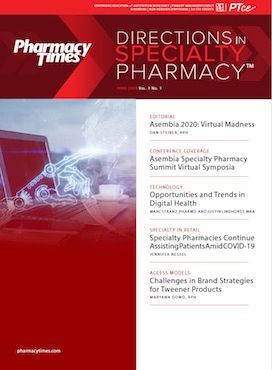Publication
Article
Specialty Pharmacy Times
CIDP Care: A Patient and Clinical Experts Weigh In
At at virtual panel discussion held in conjunction with the Asembia Specialty Pharmacy Summit, several experts covered chronic inflammatory demyelinating polyneuropathy (CIDP).
AT A VIRTUAL panel discussion held in conjunction with the Asembia Specialty Pharmacy Summit, several experts covered chronic inflammatory demyelinating polyneuropathy (CIDP). Paul Mathew, MD, DNBPAS, FAAN, FAHS, served as moderator for this dynamic discussion, which incorporated clips of an interview highlighting a patient’s perspective on the effects of living with CIDP. These videos effectively demonstrated the patient’s journey from diagnosis to navigating the health care system throughout his treatment.
Gil Wolfe, MD, FAAN, opened the panel discus-sion with a disease overview and noted that CIDP usually starts insidiously, presenting either as a slowly progressing disease or as a relapsing disease, with partial or complete recovery between the relapses. CIDP is rare, but its disabling symptoms—limb weakness, sensory symptoms such as tingling and numbness, and other motor symptoms—frustrate patients and clinicians alike. Men are affected about twice as often as women, and it can present at any age. Wolfe indicated that with appropriate treatment, which many require indefinitely, the prognosis is good.
Christine Anderson, RPh, discussed the impact of CIDP from one survey whose results showed that 47% of people reported stopping work and 32% required a cane for ambulation. Additionally, she noted that study results have shown that patients with CIDP have 7.5 times higher mean health care costs when compared with controls. Jonathan Ogurchak, PharmD, CSP, discussed treatment goals, which are to alleviate symptoms, improve functionality, and achieve long-term remission. Options include corticosteroids, plasma exchange, and immuno-globulin, which all induce short-term improvements in most patients. Health care providers need to engage patients in risk-benefit discussions when they consider treatment.
With immunoglobulin, most patients withCIDP will improve, but treatment does not come without risks and can include a range of adverse effects ranging from headache and fever to, rarely, aseptic meningitis, heart failure, myocardial infarction, and kidney failure. Wolfe added a comparison of the various immunoglobulin products available, and he highlighted the differences between them including osmolarity, immunoglobulin A content, stabilizers, and pH. Many immunoglobulin products are available; however, 4 products are currently approved for use in CIDP. Importantly, pharmacists should be aware that immunoglobulin products are approved for multiple indications and that dosing for each indication varies.
Subcutaneous immunoglobulin (SCIG) affords patients more independence and is an option for those who are stable and have poor venous access, cardiovascular risks, or adverse effects related specifically to intravenous immunoglobulin (IVIG). Ogurchak discussed patient management for CIDP. SC administration has implications for specialty pharmacists and patients, as patients need consid-erable education and support. Pumps, tubing, and administration sites are 3 aspects of care that pharmacists and patients need to address separately and then together. The interdisciplinary team needs to assess patients before transitioning them from IVIG to SCIG. Pharmacists will take the lead in calculating dosing and adjustments and should consider maximum volume per site, rate of infusion, and total sites. Additionally, pharmacists can assist in managing and mitigating adverse effects as well as other financial, information transfer, and commu-nication responsibilities.
Anderson spoke about the costs associated with immunoglobulin, indicating it is a high-spend but low-volume category. She also discussed the high cost of CIDP, stressing that between 2010 and 2012, the United States spent more than $2.1 billion on hospitalization for this population.
Ogurchak concluded the discussion by reminding participants that communication among the health care team is key, and pharmacists have an important role in monitoring appropriate use, reducing waste, maximizing benefit, and reducing cost of immuno-globulin therapy for CIDP.







